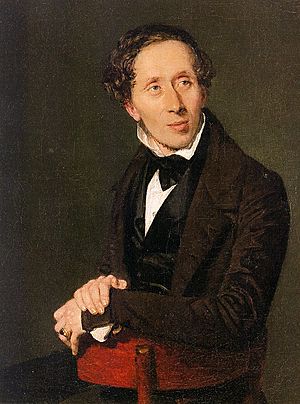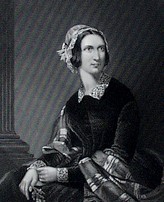Thumbelina facts for kids
Quick facts for kids "Thumbelina" |
|
|---|---|

Illustration by Vilhelm Pedersen,
Andersen's first illustrator |
|
| Author | Hans Christian Andersen |
| Original title | Tommelise |
| Translator | Mary Howitt |
| Country | Denmark |
| Language | Danish |
| Genre(s) | Fairy tale |
| Published in | Fairy Tales Told for Children. First Collection. Second Booklet. 1835. (Eventyr, fortalte for Børn. Første Samling. Andet Hefte. 1835.) |
| Publication type | Fairy tale collection |
| Publisher | C. A. Reitzel |
| Media type | |
| Publication date | 16 December 1835 |
| Published in English | 1846 |
| Preceded by | Little Ida's Flowers |
| Followed by | The Naughty Boy |
"Thumbelina" (Danish: Tommelise) is a famous fairy tale written by Hans Christian Andersen. It was first published in Copenhagen, Denmark on December 16, 1835. The story is about a very tiny girl and her many exciting adventures.
Thumbelina meets different creatures from the fields and forests, like a toad, a mole, and a field mouse. At the end of her journey, she finds a flower-fairy prince who is just her size. They fall in love and get married.
"Thumbelina" was one of nine fairy tales Andersen published between 1835 and 1837. These stories were part of a series called Fairy Tales Told for Children. "Thumbelina" appeared in the second book, along with "The Naughty Boy" and "The Traveling Companion".
Andersen created "Thumbelina" all by himself. However, he might have been inspired by other stories about tiny people. These include "Tom Thumb" and the small Lilliputians from Gulliver's Travels. At first, some critics in Denmark didn't like Andersen's stories because of their simple style. But one critic really liked "Thumbelina" and called it "delightful". This tale has been made into both animated movies and live-action TV shows.
Contents
Story of Thumbelina
A woman really wanted a child. She asked a kind witch for help. The witch gave the woman a barleycorn. She told her to plant it and see what would happen. The woman planted the barleycorn, and a beautiful flower grew. When the woman kissed the flower, it opened up. Inside, she found a tiny girl, no bigger than her thumb, who she named Thumbelina.
One night, Thumbelina was sleeping in her cradle, which was made from a walnut shell. A toad hopped through an open window and carried her away. The toad wanted Thumbelina to marry her son. She placed Thumbelina on a lily pad to keep her safe. But Thumbelina managed to escape the toad. Friendly fish and a white butterfly helped her float away on the lily pad.
Suddenly, a cockchafer (which is a type of beetle) grabbed Thumbelina and flew off with her. The beetle's friends were very proud and thought they were better than everyone else. They didn't like Thumbelina because she wasn't from their social group. The beetle quickly dropped her and flew away, leaving her alone.
Thumbelina had to live by herself in the fields. When winter arrived, she needed a warm place to stay. An old field mouse kindly gave her a home. Thumbelina thanked the mouse by helping to take care of her small house.
The field mouse thought Thumbelina should marry her neighbor, a rich and smart mole. Thumbelina hated the idea of marrying the mole. He spent all his time underground and never saw the sun or the sky.
The field mouse didn't listen to Thumbelina's worries. She kept pushing for the marriage. At the very last moment, Thumbelina flew away with a swallow to a far, sunny land. Thumbelina had helped the swallow get well during the winter, and they had been friends ever since.
The swallow carried Thumbelina to a beautiful, sunny place. In a field full of flowers, Thumbelina met a tiny flower-fairy prince. He was just her size, and she liked him very much. They got married. Her husband gave her a pair of wings so she could fly with him as he traveled from flower to flower. She was also given a new name, Maia.
At the very end of the story, the swallow flies to a poet's window. The swallow then tells the poet the whole story of Thumbelina's adventures.
Note: Mary Howitt was the first person to translate this story into English. She didn't like the part with the witch. So, in her translation, the story starts with a hungry beggar woman giving a barleycorn to a peasant's wife in exchange for food. After the barleycorn is planted, tiny Thumbelina appears from its flower.
About Hans Christian Andersen
Hans Christian Andersen was born in Odense, Denmark on April 2, 1805. His father, Hans Andersen, was a shoemaker. His mother, Anne Marie Andersdatter, was a laundress. Andersen was their only child and was very loved. He shared a love for books with his father. His father read him The Arabian Nights and stories by Jean de La Fontaine.
Together, they built fun things like pop-up pictures and toy theaters. Father and son also enjoyed long walks in the countryside.
Andersen's father passed away in 1816. After that, Andersen had to take care of himself. He was a tall, thin boy who was often picked on by other children. He wanted to escape his bullies and his poor mother, who couldn't read or write. He showed off his artistic talents by singing and dancing in the homes of richer families in Odense.
On September 4, 1819, when he was fourteen, Andersen left Odense for Copenhagen. He had some money given to him by his neighbors. He also had a letter of introduction to a famous ballerina named Madame Schall. He dreamed of becoming a poet, a ballet dancer, or an actor.
After three years in Copenhagen without much support, Andersen finally found someone who believed in him. This was Jonas Collin, the director of the Royal Theatre. Collin saw Andersen's talent. He arranged for the king to send Andersen to a grammar school in Slagelse, a town in west Zealand. Collin hoped Andersen would later go to Copenhagen University.
At Slagelse, Andersen's teacher was Simon Meisling. Meisling was interested in ancient Greece and Rome. Andersen wasn't the best student in his class, and Meisling often criticized him. "You're a stupid boy who will never make it," Meisling once told him. Many people believe that Meisling was the inspiration for the smart but grumpy mole in "Thumbelina."
Some researchers, Iona and Peter Opie, think that "Thumbelina" might be a way Andersen honored his friend, Henriette Wulff. She was small, delicate, and had a disability. She was the daughter of the person who translated Shakespeare's works into Danish. She loved Andersen, much like Thumbelina loved the swallow. However, there's no clear proof written down to support this idea.
English Versions
Mary Howitt was the first person to translate "Tommelise" into English. She published it in 1846 as "Thumbelina" in her book Wonderful Stories for Children. As mentioned earlier, she changed the beginning of the story. Instead of a witch, a childless woman received the barleycorn from a hungry beggar woman she had helped.
Other translators also gave Thumbelina different names. Charles Boner called her "Little Ellie" in his 1846 translation. Madame de Chatelain named the tiny child 'Little Totty' in her 1852 version. The editor of The Child's Own Book (1853) called her 'Little Maja'. Later, in the late 1800s, Mrs. H. B. Paulli translated the name as 'Little Tiny'.
In the 1900s, Erik Christian Haugaard translated the name as 'Inchelina' in 1974. Jeffrey and Diane Crone Frank used 'Thumbelisa' in their 2005 translation. Today, you can find modern English versions of "Thumbelina" in complete collections of Andersen's tales, like the one by Jean Hersholt from the 1940s or Erik Christian Haugaard’s translation from 1974.
Movies and Shows
Thumbelina has been made into many different types of media. The first animated version was a silent, black-and-white movie released in 1924 by director Herbert M. Dawley. Lotte Reiniger made a 10-minute movie in 1954 using her special "silhouette" puppets.
Don Bluth's full-length animated movie, Thumbelina, is one of the most well-known versions. The story was also adapted into a live-action TV show called Faerie Tale Theatre, starring Carrie Fisher. In 2009, an animated movie called Barbie Presents Thumbelina was released directly to DVD. Countries like Russia and Japan have also created their own animated versions of the story.
|
See also
 In Spanish: Pulgarcita para niños
In Spanish: Pulgarcita para niños



